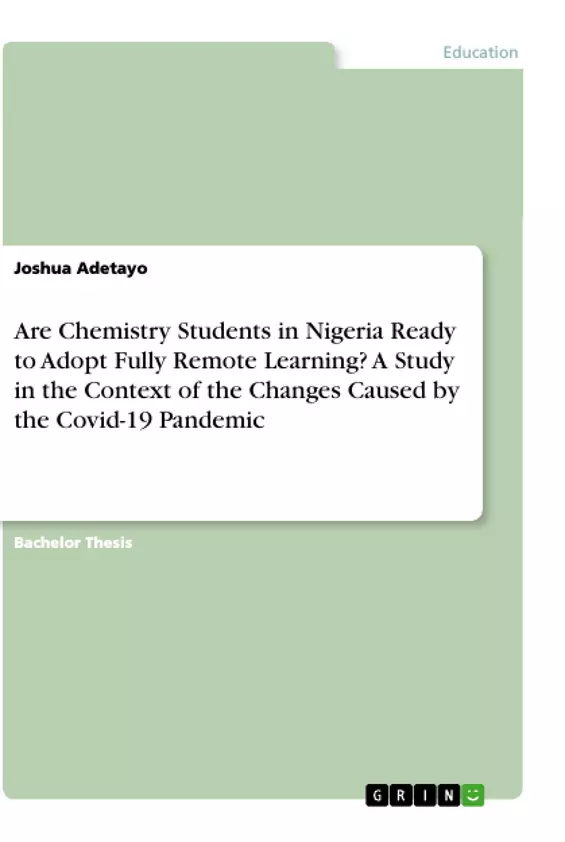This study is aiming at finding the uses of remote learning in the teaching and learning of chemistry in secondary schools. The study is therefore interested in the effective teaching and learning of chemistry by introducing remote learning to educational system in Nigeria in other for bring about positive impact on education. It also examines effectiveness of remote learning on teaching and learning can be sustained during emergency situations.
This study will be designed to examine the readiness of the students in adopting. Four research questions were raised to guide the study: What are the tools/facilities available for remote learning? Do the students possess the skills for remote learning? Do students have access to remote learning facilities? What are the challenges facing the implementation of remote learning?
Covid-19 pandemic forced many schools to abruptly adopt full-online remote learning. Such unprecedented abrupt adoption requires a degree of student readiness to ensure the success of learning delivery. However, the students in secondary schools have no level of awareness to adopt remote learning in Nigeria. Majority of the students has no skills towards the use of remote learning and also have no access to the facilities/tools in implementing remote learning. Therefore this study intends to investigate the students’ readiness to adopt fully remote learning in the teaching and learning of Chemistry.
Inhaltsverzeichnis (Table of Contents)
- CHAPTER ONE: INTRODUCTION
- 1.1 Background to the study
- 1.2 Statement of the Problem
- 1.3 Objective of the study
- 1.4 Research questions
- 1.5 Significance of study
- 1.6 Scope/Limitation of the study
- 1.7 Definitions of Terms
- CHAPTER TWO: REVIEW OF RELATED LITERATURE
- Introduction
- 2.1 Concept of Remote Learning
- 2.1.1 Place of the Remote Learning platform in the Implementation of Pedagogical Practices
- 2.2 Factors that Influence Students' Adoption of Remote Learning
- 2.3 Emergencies Situations that calls for Remote Learning
- 2.4 Tools/Facilities for teaching and learning in Remote Learning
- 2.5 Students awareness/skills in Remote Learning
- 2.5.1 Technology Usage in Remote Learning
- 2.5.2 Self-Efficacy
- 2.6 Teaching and learning of Chemistry through remote learning
- 2.7 Challenges facing the implementation of Remote learning
- CHAPTER THREE: RESEARCH METHODOLOGY
- 3.0 Introduction
- 3.1 Research Design
- 3.2 Population of the Study
- 3.3 Sample and Sampling Technique
- 3.4 Research Instrument
- 3.5 Validity and Reliability of the Instrument
- 3.6 Method of Data Collection
- 3.7 Method of Data Analysis
- CHAPTER FOUR: PRESENTATION, ANALYSIS OF DATA AND DISCUSSION OF FINDINGS
- 4.1 Introduction
- 4.2 Data Analysis
- 4.3 Discussion of Findings
Zielsetzung und Themenschwerpunkte (Objectives and Key Themes)
This study investigates the readiness of chemistry students to adopt fully remote learning. The research aims to explore the factors influencing students' adoption of remote learning, assess their awareness and skills in using technology for learning, and identify challenges associated with the implementation of remote learning in the context of chemistry education.
- Factors influencing students' adoption of remote learning.
- Students' awareness and skills in utilizing technology for learning.
- Challenges related to the implementation of remote learning in chemistry education.
- The role of technology in facilitating remote learning in chemistry.
- The potential impact of remote learning on chemistry education.
Zusammenfassung der Kapitel (Chapter Summaries)
- Chapter One: Introduction - This chapter provides background information on the study, defining the problem, outlining the objectives, research questions, and significance of the research. It also addresses the scope, limitations, and defines key terms used in the study.
- Chapter Two: Review of Related Literature - This chapter examines existing literature on remote learning, exploring the concept of remote learning, its implementation, and the factors influencing students' adoption. It also analyzes tools, facilities, and challenges associated with remote learning in education, particularly in the context of chemistry education.
- Chapter Three: Research Methodology - This chapter details the research design, population of the study, sampling technique, research instruments, validity and reliability of the instruments, data collection methods, and data analysis techniques employed in the research.
- Chapter Four: Presentation, Analysis of Data and Discussion of Findings - This chapter presents and analyzes the data collected through the research. The findings are then discussed in relation to the research questions and the existing literature.
Schlüsselwörter (Keywords)
The study focuses on key topics such as remote learning, chemistry education, student readiness, technology adoption, educational challenges, and the use of online platforms in learning.
- Citation du texte
- Joshua Adetayo (Auteur), 2021, Are Chemistry Students in Nigeria Ready to Adopt Fully Remote Learning? A Study in the Context of the Changes Caused by the Covid-19 Pandemic, Munich, GRIN Verlag, https://www.grin.com/document/1159544



